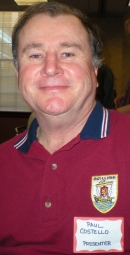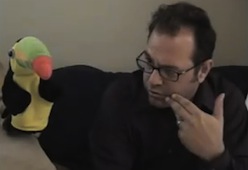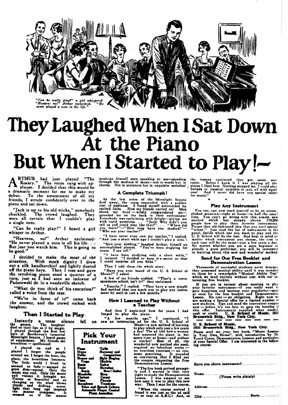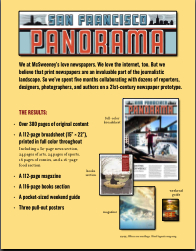Why does the public buy into stories like the Balloon Boy? Why do the media purvey stories that are often not as they are portrayed to be — and the public gets sucked in?
Those were questions raised yesterday in a thought-provoking teleconference by Paul Costelllo, director of the Center for Narrative Studies in Washington, DC.
I had seen Costello give a powerful keynote address at this year’s Golden Fleece Day in April, and he was my partner in one of the icebreaker activities we did that morning (hence, the lovely closeup photo of him at right). He’s a stimulating thinker and presenter.
Costello is developing a narrative critical method that suggests that we stand at a distance from a given story — on the balcony, as he says — and look at the big picture, the patterns that emerge. He suggests we ask: What’s the story of the story?
Other examples of stories that were not what they seemed include the Columbine shootings (misconceptions about which were cleared up in a 10th anniversary book by Dave Cullen), weapons of mass destruction in Iraq, Bernie Madoff, subprime loans, and the death of Pat Tillman.
Just as storytellers make choices in how they choose to tell stories, Costello says, the audience has a choice in how we consume the stories.
Costello applied his narrative critic al method to his book The Presidential Plot. The teaser for the book here gives a flavor for Costello conveyed in yesterday’s teleconference:
Stories are great to share but do they really make any difference to the world? This book takes the 2008 election as a Case Study to show that a narrative critical method can bring a whole new explanatory power to our understanding of the public stories and their impact on us as citizens. It begins by asking Why are we suckers for a good story? … We bought the story that we need to go to war. We bought the story that fraudulent companies like Enron were re-inventing the energy business. (They were — it was pure invention). We bought the story about our innocence and our exceptionalism, that told us that we don’t torture and our military don’t lie, and most recently, we have been sold the tale that our money is as safe as a bank ! That has proved to be too true.
Costello’s current initiative is applying his narrative critical method to the Middle East, an effort called New Story Leadership, described on its site like this:
New Story Leadership for the Middle East (NSL) addresses [old stories of grievance, suspicion and fear, recycled endlessly, that have kept generations of Israelis and Palestinians from imagining and moving toward a future free of conflict] by offering Israeli and Palestinian college students a transformative leadership experience in America that will help inspire a new story of possibility for their generation. [you can find many more details about the project on the site]
Narrative critical method is a way to diagnose what are often diseased story systems, Costello says, and to design new story architectures that fit the systems. You must ask: Can you get to where you want to go using X story? Thus, in the case of the Middle East, Costello says, the question is: Can you get to peace using the current story? No, Costello says, you can’t get to peace with the old story, so you must change the story.
Put another way, the question is: “What has to go into the story for X to be the ending?”
And just why do we get sucked into stories that turn out to be something they are not? Costello says we have habitual narrative vulnerabilities — fear, for example — that make us susceptible. He talks about a “military-industrial story complex,” stories as products, and audiences as consumers of these products who have the ability to choose the way we wish to consume stories.
So many of the stories we’re subjected to could benefit from narrative critical analysis. We truly need to ask: What’s the story of the story? I’m excited by Costello’s potentially world-changing methods and initiatives.











